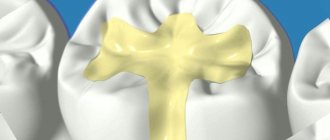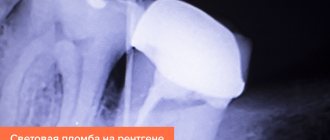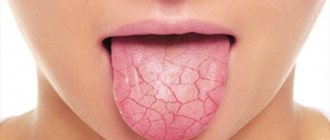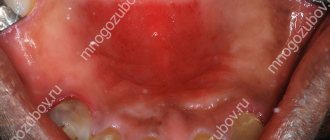Dental treatment is a medical procedure that corrects a smile, corrects imperfections and relieves pain. However, discomfort after dental surgery, in particular after installing a filling, does not go away immediately.
In 90% of cases, mild pain is natural, since the filling affects nerves, canals, and tissues. It takes time for the filling to “take root”. During this period, the pain can be constant, fading or variable, provoked by irritants: hot tea, strong pressure on the gums, etc.
But there are other pains - pathological ones. They require new medical intervention and careful treatment. Let's consider each option in more detail.
Content:
- When is a non-permanent filling indicated?
- Why does a tooth with a temporary filling hurt?
- When to sound the alarm
- What to do if a tooth hurts under a temporary filling
- Preventive measures
Most often, people rush to the dental clinic because of pain.
Naturally, every person hopes that he will return home with a healthy tooth. Unfortunately, this is not always the case. Often in dental practice there are situations when the doctor has to put a temporary filling instead of a permanent one. It is distinguished by its low cost and loose structure. It is loosely held in the carious cavity and quite quickly falls out on its own or decreases in volume. These features are due to the fact that the temporary filling material must be easily removed. The problems it solves:
- protection of the carious “hollow” from the accumulation of food debris and the penetration of pathogenic bacteria;
- preventing premature loss of medication from the “hole”.
Reason one. Injury
If you were hit in the jaw or fell, after which the symptoms described above appeared, then it is likely that as a result of this incident the pulp, which is a neurovascular bundle, was damaged. As a result of the injury, it became inflamed, swelling formed, and now there is a feeling of compression of the hard tissues that surround it. In this case, the first signal will be itching, only after it does throbbing pain appear.
Also, the tooth can change its color - suddenly acquire a shade from gray to pinkish. The latter signals that serious damage has been sustained and the pulp has begun to die as a result of inflammation.
Why does a tooth with a temporary filling hurt?
Often the temporary filling hurts. Among the main reasons for this problem are:
- Serious damage to dentin tissue. Injuries to dentinal tissues when treating a carious area with a drill cannot be avoided. Dentin has the ability to heal itself, but this does not happen overnight. Soon everything will return to normal - the patient just needs to be patient.
- Overheating of the dentinal zone. It happens if the doctor worked with the drill for too long and did not use water cooling in the process of cleaning the “hole”. It may also be a consequence of the use of faulty medical equipment.
- The filling height is too high. Then, when pressing on the tooth, acute pain appears. You shouldn't tolerate it. The most reasonable thing is to make an appointment with a doctor and ask him to remove the excess material. In general, this reason is rare, since before sending the patient home, a good specialist always makes sure that the material is standing properly and does not take up excessive space.
- Exceeding the prescribed treatment period. The doctor clearly announces when you need to come for a follow-up appointment to remove the stored medicine. But some people ignore such instructions and walk with the material longer. Then there is a destructive effect on the tissues of the unit, aching or acute pain appears. A medicinal composition whose service life has long expired becomes toxic. It disrupts metabolic processes occurring in local tissues. Promotes crown destruction. Cracks form on the surface of the latter.
- Individual intolerance to the prescribed filling composition. Sometimes in dental practice there are allergies to the drugs used. Then, after laying the material, swelling appears. The tooth starts to hurt.
- Partial destruction of the seal. The formed depression may be very small and, quite possibly, the person will not even notice that any changes have occurred to his tooth. Meanwhile, pathogenic organisms will begin to penetrate through the hole that appears into the deep tissues. This will cause inflammation. The unit will begin to react painfully to temperature changes, spicy, salty and sour foods.
It is important to understand what is causing the pain symptoms. The patient cannot do this on his own, since this involves an in-person examination in the dentist’s office. You need to make an appointment with a doctor as soon as possible and undergo the treatment he suggests.
PS
In this article, we deliberately do not touch upon mistakes made by dentists that may cause pain. God forbid that a seed of doubt should be planted in you. It is very important to trust your doctor or better look for another! Any doctor will say that the most difficult patient is the patient who does not believe in his recovery. But if you have doubts about the doctor’s competence, then the best decision is to go to another for a second opinion. Take pictures before and immediately after treatment, and keep these pictures for yourself. This will help prove you are right if something goes wrong. And trust your doctor!
The situation where pain may occur is quite predictable. In such cases, the dentist always warns the patient about possible pain. And if the pain goes away after a week or two, then there is nothing to worry about.
When to sound the alarm
Is it normal for a tooth with a temporary filling to hurt a lot? No. Mild discomfort is possible, but long-lasting acute pain is a reason to visit the doctor again. However, this should be done as soon as possible. It is especially dangerous if a person’s well-being worsens at night, swelling has formed or a purulent “bump” has appeared - all this may indicate the rapid progression of dangerous complications.
What kind of pain can there be and what problem does it indicate:
- The tooth aches constantly. The state of health after the last visit to the dentist does not worsen, but does not improve either. This is possible if you are allergic to a dental composition, use too high a dose of the drug (intoxication occurred due to an overdose), or use a very low dose of the drug (the infection could not be stopped and it continues to actively progress).
- Discomfort appears only when pressing on the diseased unit. Here one should suspect traumatic damage to the periodontium due to the artificial overestimation of the dental crown.
- Unbearable pain appears even with a slight touch to the tooth. Perhaps a fragment of a medical instrument remains in the canal or acute periodontitis has developed.
- There are attacks of pain. This happens when the purulent form of pulpitis is advanced.
Emergency measures
When you have a toothache after installing a temporary filling, you should immediately seek help from a dentist:
- body temperature “jumped” sharply;
- there was a feeling of weakness, general malaise;
- gums and cheeks are inflamed and swollen;
- there was a putrid taste in the mouth;
- swallowing and chewing became painful.
So, after installing a temporary filling, pain may occur for natural and pathological reasons. You can cope with discomfort using traditional and folk remedies (only on the recommendation of a doctor). If the pain syndrome is accompanied by other systemic symptoms (fever, swelling of the face and soft tissues of the oral cavity), this is a reason to immediately seek help from a dentist.
What to do if a tooth hurts under a temporary filling
The first thing a patient should do is get qualified medical care. Remember: for acute pain, all dentists accept appointments without an appointment. If for some reason a visit to the dentist has to be postponed for one or two days (for example, discomfort occurred on the weekend), you will have to self-medicate. This may include:
- Taking a safe analgesic. It is advisable to consult with your dentist in advance about acceptable medications that reduce pain symptoms. Such drugs should always be selected on an individual basis, as they have a large number of side effects and contraindications.
- Rinsing the mouth with a solution of salt or soda. Decoctions of chamomile and sage have proven themselves well. It is also acceptable to periodically apply an anesthetic dental gel to the gums.
It is possible that after the examination the specialist will say that there is no cause for concern. Then the patient will have to complete the prescribed period, relieving pain with analgesics.
Under no circumstances should you force the process of replacing a temporary filling material with a permanent one. This can lead to serious complications in the future. Then you will have to unseal and carry out treatment from the very beginning.
"Age" features
Itchy sensations can occur at any time. This is due to various reasons, depending on whether a child or an adult suffers from unpleasant manifestations. Let's consider the main cases typical for certain categories of patients.
Itching in childhood
This is one of the most common signs of milk eruption. In infancy, babies cry a lot, are capricious, pull various objects into their mouths, and sleep poorly. Parents may notice excessive swelling of the mucous membranes of the oral cavity, a change in color to reddish or even bluish. After a certain period of time, white stripes appear on the fabrics. This means that the incisor is coming to the surface and will soon appear entirely.
Older kids complain about similar things. This means that the first bite is replaced by a permanent one. Moms and dads should not ignore this process; it is important to involve a specialist so that he can observe whether everything is happening correctly. If the slightest deviation from the norm is detected, the doctor prescribes the necessary diagnostic tests and develops treatment tactics.
When does the symptom appear in adolescents?
If the problem affects a person during adolescence, this indicates the development of a pathological process. In this case, you cannot do without a thorough diagnosis and medical examination. Often we are talking about hidden inflammation inside the gums or teeth. The sooner therapy is started, the faster it will be possible to get rid of the problem and avoid various complications.
Itching and scratching are often observed when installing braces. This happens both immediately after installation and as a result of a planned correction of the tension force of the metal arc.
As an adult
Provoking factors in older patients can be anything. More often it is smoking, excessive alcohol consumption and other bad habits, allergies to filling materials and prostheses, crowns. In some cases, the cause may be inflammation of the soft tissues, as well as diseases such as gingivitis, stomatitis, periodontitis, glossitis.
Often, men and women experience neurological disorders that lead to itchy sensations. With mental stress, bruxism (grinding in sleep) sometimes occurs.
When the orthopedic design is not selected correctly, it scratches the gums and tongue. The same applies to the installation of crowns and fillings, which cause discomfort of varying severity.
Preventive measures
In order for the process of preparing for the main treatment to proceed without unpleasant surprises and dangerous complications, you must follow simple rules:
- Try not to put stress on the sealed unit. This means that you should chew food from the “healthy side”. Under no circumstances should you chew on foreign objects. Also, intensive rinsing should not be done unless prescribed by a doctor.
- Maintain good oral hygiene. It is necessary to carry out hygiene measures in the morning and evening. Inflamed areas of the gums can be treated with a brush with soft bristles.
- Check the temporary filling for cracks and chips. If they appear, a re-sealing should be carried out. Otherwise, by the time the permanent material is installed, there may be nothing left of the dental crown - it will collapse under the aggressive influence of pathogens.
Watch your tooth filled with a temporary filling carefully. Then you will avoid many problems.
Standard activities after installation of the material
Do not drink or eat until the material has completely hardened, as it may crack or fall out completely. Also, food can get into the cavity of a molar or premolar. After a non-permanent filling, it is not recommended to eat soft food for the first 2-3 hours, and hard food for 10-12 hours. This will avoid a number of negative consequences. When chewing solid food in the future, you should use less of the side on which the filling was performed.
While wearing the material, hygiene rules must not be neglected. You should brush your teeth twice a day, and after eating, rinse your mouth with antiseptic solutions and floss. If the temporary material is installed for several months, it is recommended to use a brush with softer bristles during this period. To avoid possible complications, the material is removed on a strictly designated day.
Symptoms of needing root canals
If you experience prolonged pain from cold or hot water, lasting several minutes, you should suspect inflammation of the nerve in the tooth. The pain can increase gradually, occur after a filling is placed, or with severe tooth decay due to a cold, decreased immunity, stress, or hypothermia. If pain occurs when food hits a certain tooth, when you press on it or tap it with a spoon, then you can assume inflammation of the apical tissues around the root - periodontitis. Cleaning the canals, treating them with medication and filling them is necessary to prevent the spread of inflammation to neighboring areas. In severe cases, complications such as periostitis, osteomyelitis, abscess or phlegmon develop, the latter is treated in a hospital. If the nerve or gangrenous tissue from a tooth is not removed in time, the risk of losing the tooth itself increases over time.
Consumer Reviews
Mrs. Doubtfire about Asepta Active mouth rinse (irecommend.ru):
“When I was faced with a serious gum problem, this rinse was recommended to me by a dental surgeon.
Asepta Active mouthwash is a medical product and is sold only through the pharmacy chain. The instructions recommend taking breaks in use. Personally, I use it in courses and during exacerbations of gum inflammation. I've been using it for about 2 years.
The mouthwash is minty, pleasant, slightly astringent. Improvement is felt from the first use. Bottle volume 150 ml. Manufacturer: Russia, St. Petersburg. A convenient measuring cup is included.
You can (better) buy it as a set, which also includes balm and toothpaste, which comes as a gift.
I’m very happy that such products from a domestic manufacturer have appeared!”
julia-06 about Asepta Active mouth rinse (irecommend.ru):
“A very good rinse for problem gums.
She had never encountered the problem of bleeding gums, but at her next visit to the dentist she noticed that when she only lightly touched her gums, they began to bleed. So the dentist gave me a mini version of Paradontax toothpaste and advised me to use a mouthwash after brushing my teeth. Mom bought Asepta active mouth rinse.
For some reason I used to be very skeptical about such remedies, but as it turned out, in practice it helps very well. My problem went away completely, my gums stopped bleeding. I don’t even want to read the ingredients and go into its details, it’s unlikely that everything is super natural, but since it helps, I give the mouthwash a solid 5 points. Of course, each case is individual, but I will recommend it based on my experience. And the price of the rinse aid is quite reasonable.”
Tooth itching during pregnancy
Women expecting a baby experience a whole range of unusual and sometimes unpleasant symptoms. In more than 50% of cases, expectant mothers experience gingivitis and bleeding gums. This is due to both changes in hormonal levels and a lack of certain substances in the body (for example, calcium), which in large quantities are used to ensure the normal functioning of the fetus in the womb. The enamel and hard tissues become thinner, and hyperesthesia appears.
Sometimes the symptom is associated with emotional stress. A pregnant woman is very worried about her baby, and constant stress, as we know, does not entail anything good. As a result, pathological processes such as caries, periodontitis, and pulpitis are diagnosed.
Every woman during pregnancy should be checked by a dentist. In no case should oral diseases be ignored and therapy avoided. There are many safe but effective interventions that do not harm the child.











